Landing Page SEO
Chapter 10 Of $100M SEO for startups course

Written by Jan-Oliver Seidenfuss
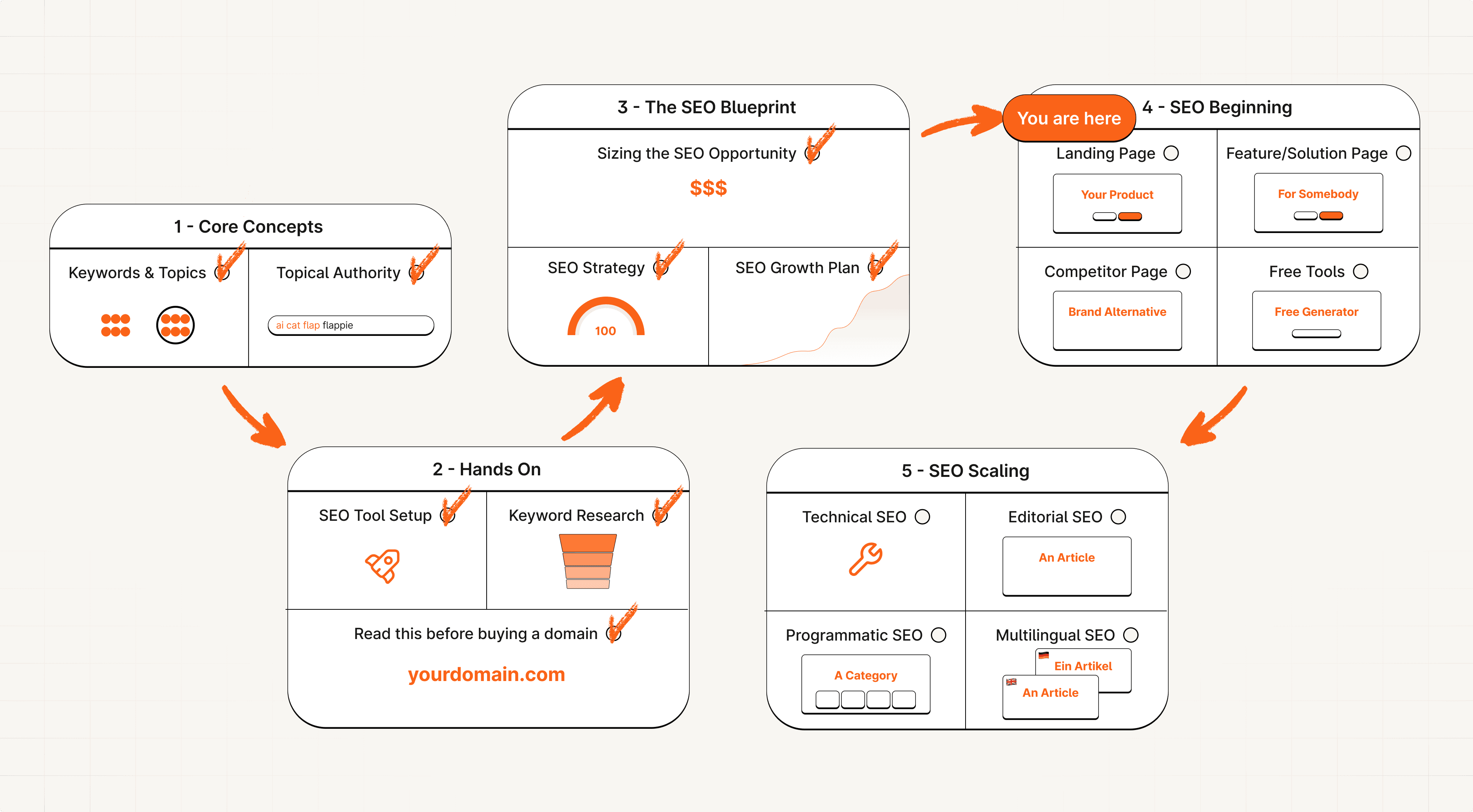

Here are the 5 easy steps to optimise your landing page for SEO.
If you want to rank your landing page higher, you'll love this guide.
Here are the 5 easy steps to optimise your landing page for SEO.
If you want to rank your landing page higher, you'll love this guide.
Here are the 5 easy steps to optimise your landing page for SEO.
If you want to rank your landing page higher, you'll love this guide.
About this Course
Course Chapters

Course Chapters

This is chapter 9 of our SEO For Startups course.

If you aren't following along, don't worry.
I'll include links to previous chapters for context. This way, you can easily catch up on any necessary background information.
Enjoy! ✌️
This is chapter 9 of our SEO For Startups course.

If you aren't following along, don't worry.
I'll include links to previous chapters for context. This way, you can easily catch up on any necessary background information.
Enjoy! ✌️
This is chapter 9 of our SEO For Startups course.

If you aren't following along, don't worry.
I'll include links to previous chapters for context. This way, you can easily catch up on any necessary background information.
Enjoy! ✌️
Step #1 - Find your Product focused Topic
The keywords/topic we want to optimise our landing page for, fall into the solution aware stage of the customer journey.
What do I mean by that?
The customer journey separates potential customers into distinct stages of awareness, from realising they have a problem to choosing a solution.
People in this solution aware stage know they have a problem and have seen a solution. But they aren’t aware of any specific brands or products.
Let's use Flappie as example.

For Flappie, people in the solution aware stage have a cat that brings home prey. They know there are cat flaps that prevent this. But they don't know any specific products or brands.
The question then is, what keywords are they using on Google to find products/brands?
Great question.
The thing is, it's not just one search term they are using.
For startups, there are 4 different perspectives we can take on finding these topics/keywords:
Product focused - People search for your product directly (e.g. cat flap with prey detection)
Feature focused - People search for a feature of your product (e.g. cat flap with app)
Solution focused - People search for a specific solution (e.g. cat flap for high prey drive cats)
Competitor focused - People know a competitor and are looking for alternatives
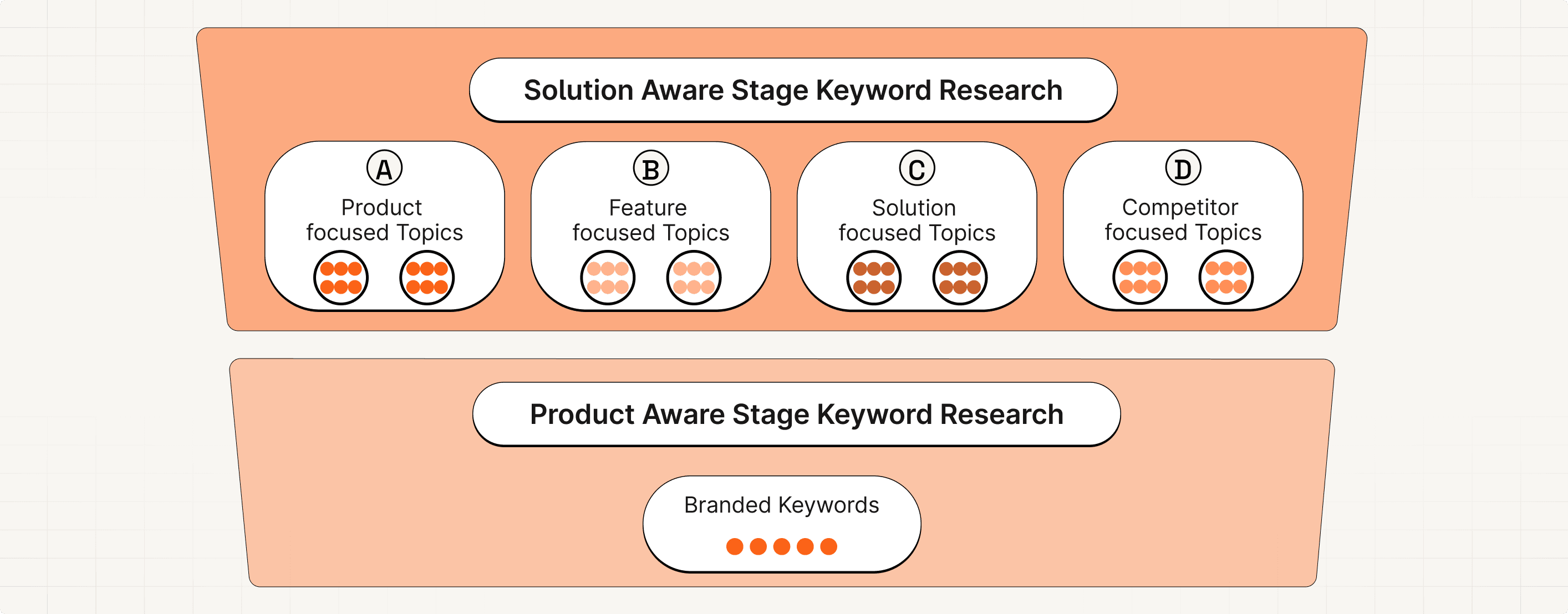
For optimising the landing page, we are only interested in the product focused topics.
But why?
Well, when people search for your product exactly, ideally your landing page ranks.
And what happens to the feature, solution & competitor focused topics?
As we've seen in the SEO Strategy chapter, the other topic types map to feature/solution pages and competitor pages. All will be covered in the next chapters.
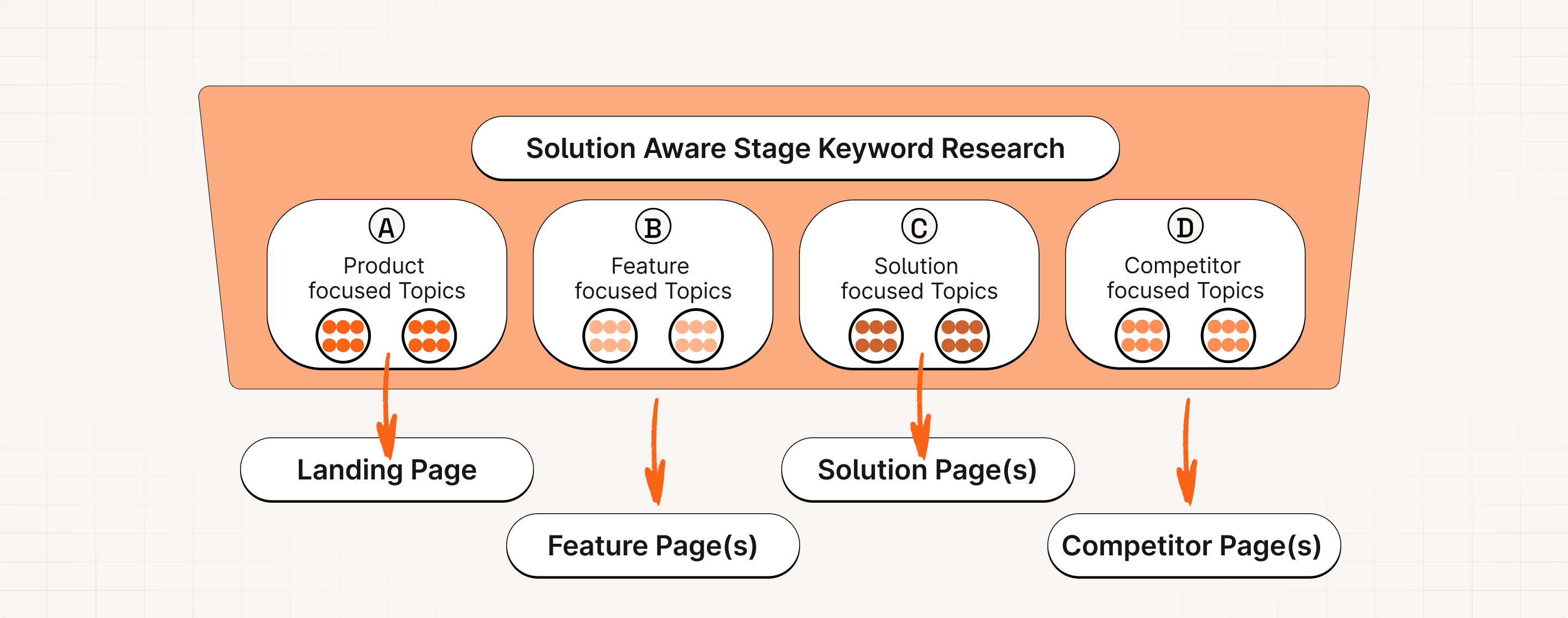
Great!
Now let's look into my bulletproof way of finding the product focused topics/keywords.
Again, these are the terms people put into Google that describe your solution without any doubt. An example for Flappie could be "cat flap with prey detection".
If you follow the course, you'll realise that we covered this in the Keyword Research chapter already. Feel free to skip to step #2 if you know your product focused topic already.
Step A: Start by brainstorming potential keyword ideas that exactly describe your product. Add them to your list.
Step B: Use Google Search Console & select your landing page to find keywords you already rank for. Extend your list.
Step C: Use Google Keyword Planner to find keyword ideas based on your and your competitors landing page. Extend your list.
Step D: Use the aggregated keywords from step 1 - 3 as starting point in Google Keyword Planner to find more keywords - keywords in, keywords out! Also note down the search volume.
Step E: Cluster the list of keywords into topics by putting them into Google and checking if they have an overlap of 3+ urls.
Step F: Doublecheck the intent to make sure they are really product focused topics.
Follow along step by step.
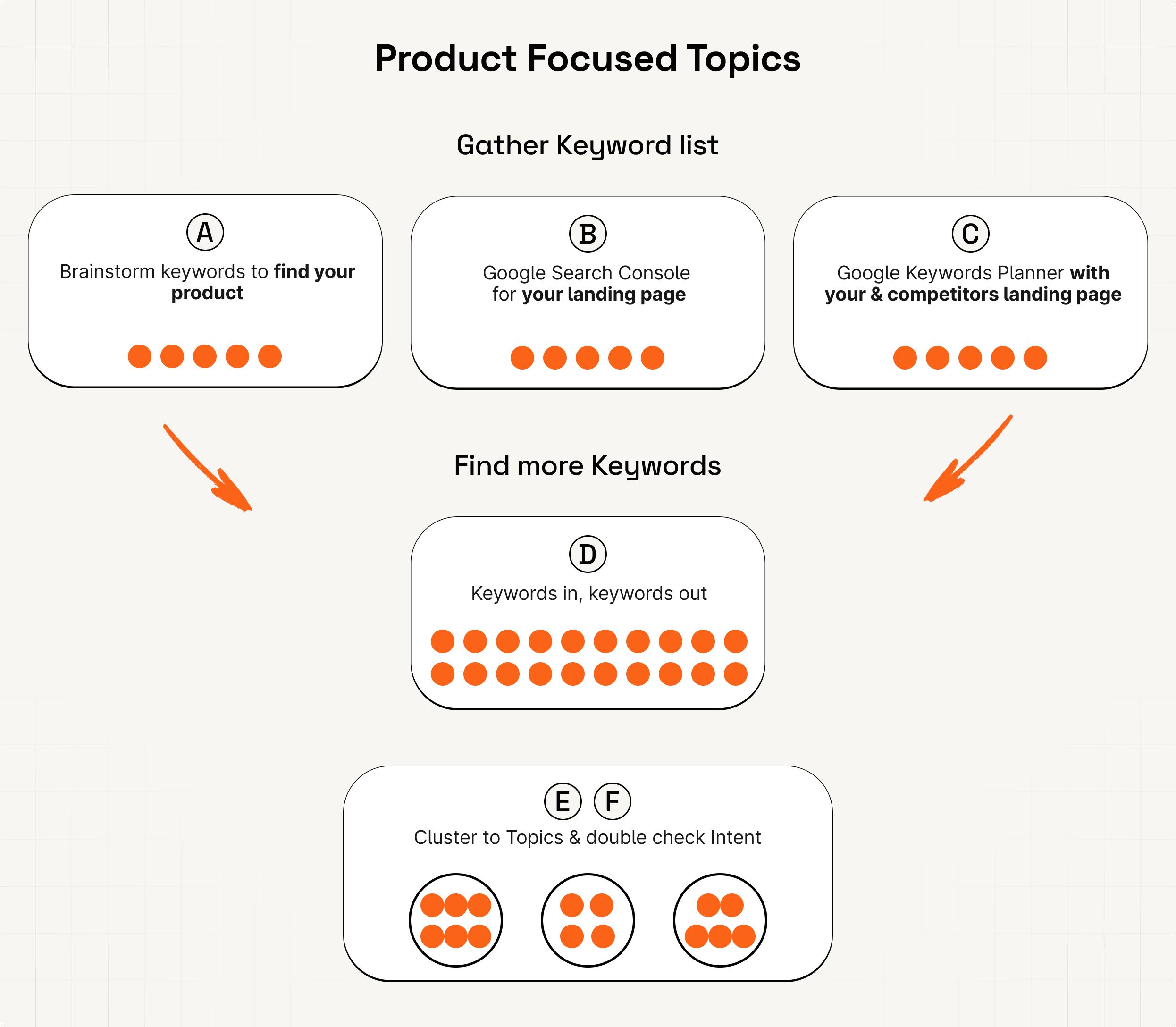
Step A - Brainstorming
The goal here is to come up with a list of 10-15 potential search terms you would use to find your product.
Put yourself in the shoes of a potential person searching for it.
What are you asking Google that exactly describes your offering?
It shouldn't be too broad. Too narrow is fine.
For Flappie, the term cat flap would be too broad. It doesn't exactly describe the core of Flappie's offering.
But something like this is perfect.
cat flap that detects prey
cat flap that prevents cat from bringing home prey
cat flap with mice detection
smart cat flap
ai cat flap
cat flap with camera
You get the point!
But don't worry if you add too broad things by accident. We'll filter it out later.
Step B - Google Search Console
Google Search Console provides us with information on the keywords people use to find our landing page.
To find them, open Google Search Console & navigate to the pages tab.
Click on your landing page.

This enables the landing page as a filter option.
Now, switch to the queries tab and you'll see all keywords people use to find your landing page.
See if there's something you can add to your list.
Again, you are only searching for keywords that exactly describe your product.
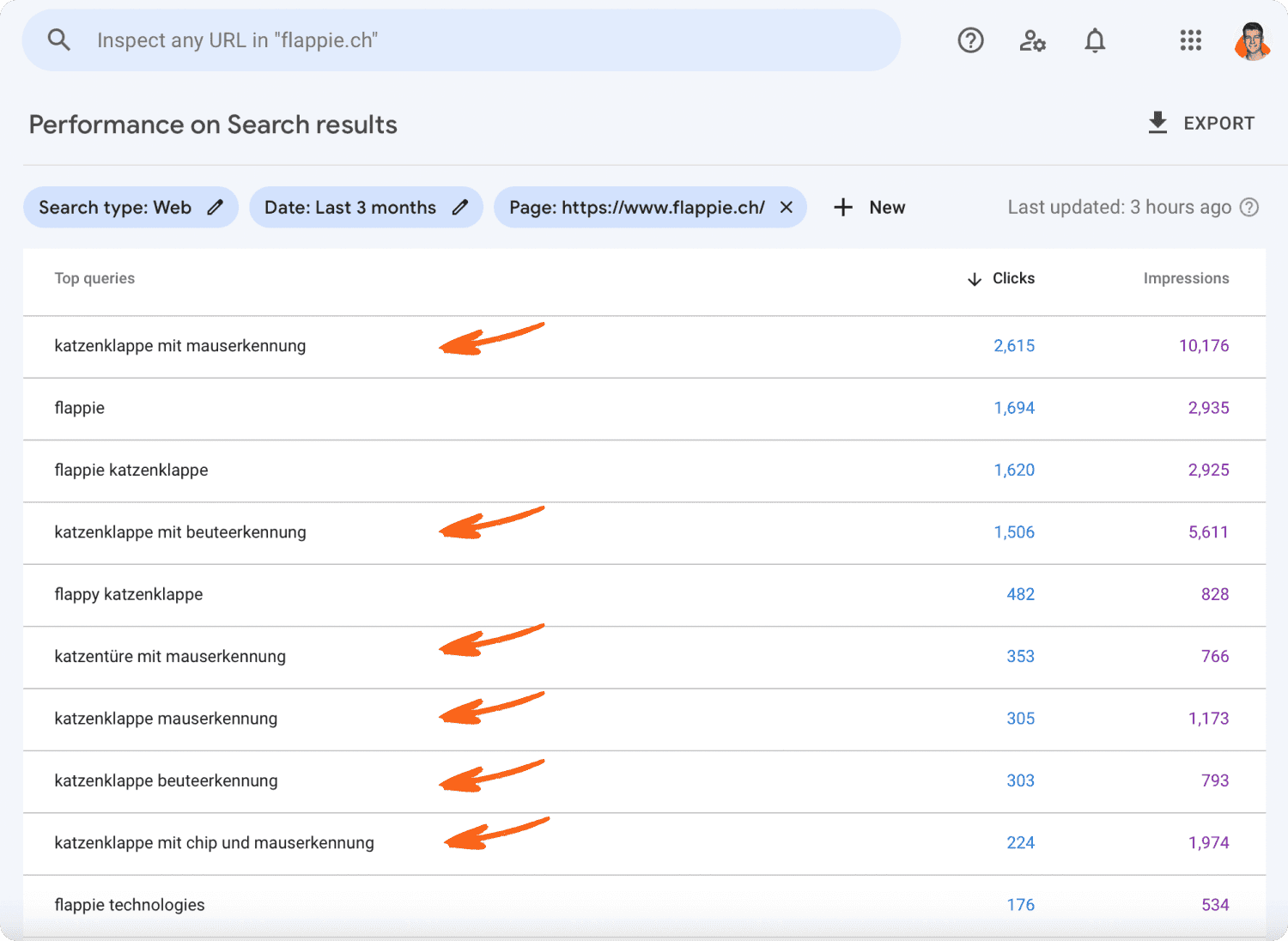
For Flappie there are quite a few I haven't thought of so far.
They are in German but I’ll translate them for you.
cat flap with mice detection
cat flap with prey detection
cat door with mice detection
cat flap with mice detection
cat flap with prey detection
cat flap with chip and mice detection
These are great.
Add everything you find to your list.
If you only see branded searches, don’t worry.
Just move on.
Step C - Page based Keyword Ideas
Google Keyword Planner gives us keyword ideas based on a website url.
To find product focused keywords, we'll use our landing page as website url.
Navigate to Google Ads and open the Google Keyword Planner.
Select the Start with a website option and paste your landing page url in there.
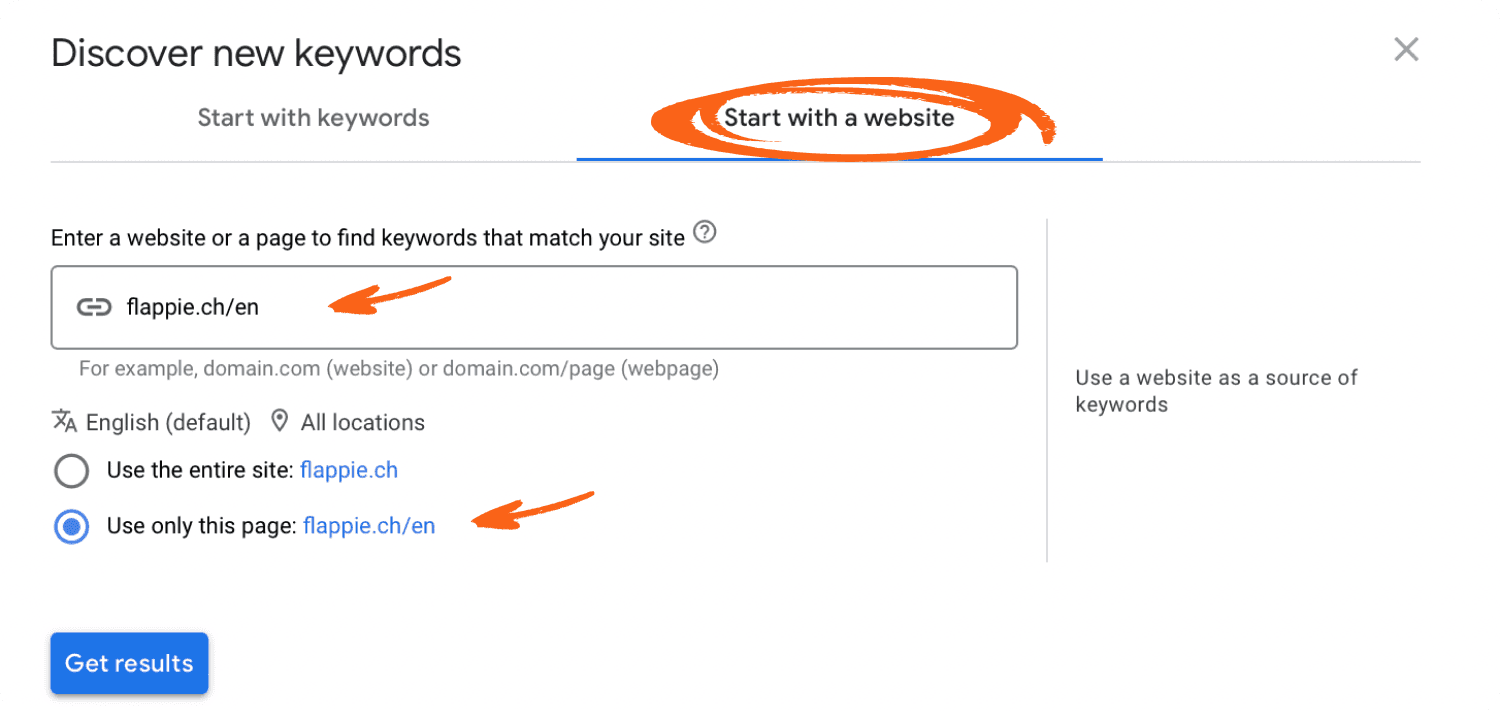
Make sure to select the correct location, language & only this page.
Let's see Flappie as example. I will use the English version of their website so you can understand the suggested keywords.
Hit the Get results button.
You now have a list of keyword ideas.
Good stuff!
Add new keywords to your list.

Instead of your own landing page you can also add the landing page of your direct competitors.
Step D - Keywords In, Keywords Out
Fantastic, you should now have a list of keywords.
We'll now put them into Google Keyword Planner to find even more.
I call this keywords in, keywords out.
Use the start with keywords tab and add up to 10 keywords of your list from Steps 1-3 at a time.
Click get results to receive a list of keyword ideas.

Add everything that comes up and you think makes sense to your list.
Make sure to add the monthly search volume to all keywords. If you see a search term does not have any searches, remove it from the list.
Grow your list. Rather add too much than too little. We'll filter out in step 6 again.
For Flappie I am left with something like this.
cat flap with camera (50 searches/m)
cat flap camera (40 searches/m)
ai cat flap (140 searches/m)
ai cat door (70 searches/m)
ai powered cat flap (10 searches/m)
cat flap mouse detection (40 searches/m)
cat flap that detects mice (30 searches/m)
cat flap that detects prey (70 searches/m)
Great!
Step E - Cluster Keywords to Topics
So far we found a bunch of keywords that people put into Google.
But remember, topics are the new keywords.
We've seen that a topic is a cluster (=group) of keywords with the same intent. Meaning that people have the same intention when putting either of these keywords into Google.
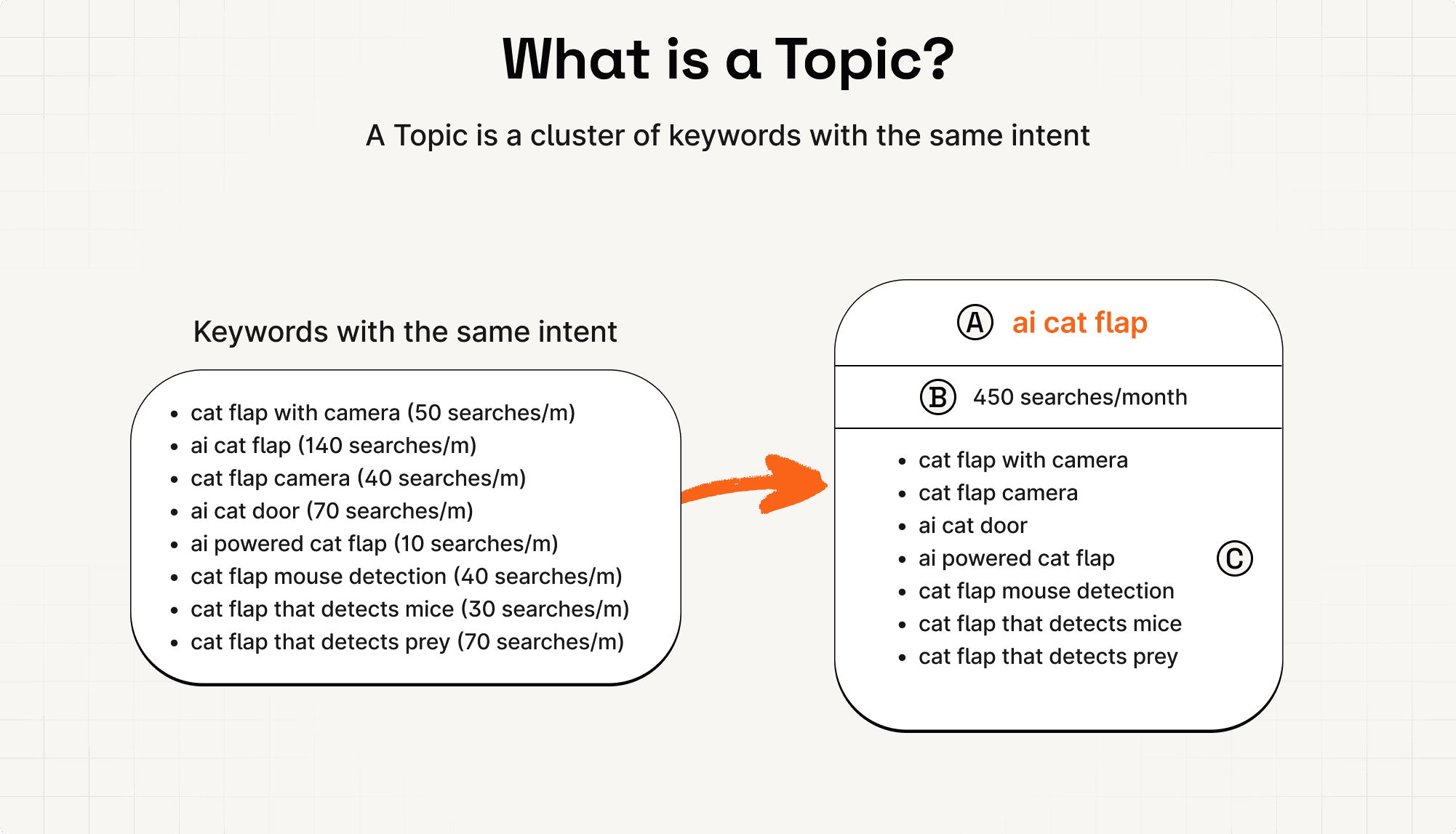
The topic name (A) is thereby the keyword with the largest monthly search volume. It is also called the primary keyword.
The total monthly search volume of a topic (B) is the sum over all keywords. If you calculate the sum over all keywords on the left side, you'll see that it is 450.
The other keywords (C) are called cluster keywords.
So we need to cluster our list of keywords from steps 1-4 into topics.
But how?
It's simple - put the keywords into Google and see which ones have an overlap of 3+ urls.

If you feel lost, check the previous chapter on the relation of topics and keywords.
For Flappie, I am left with only one topic.
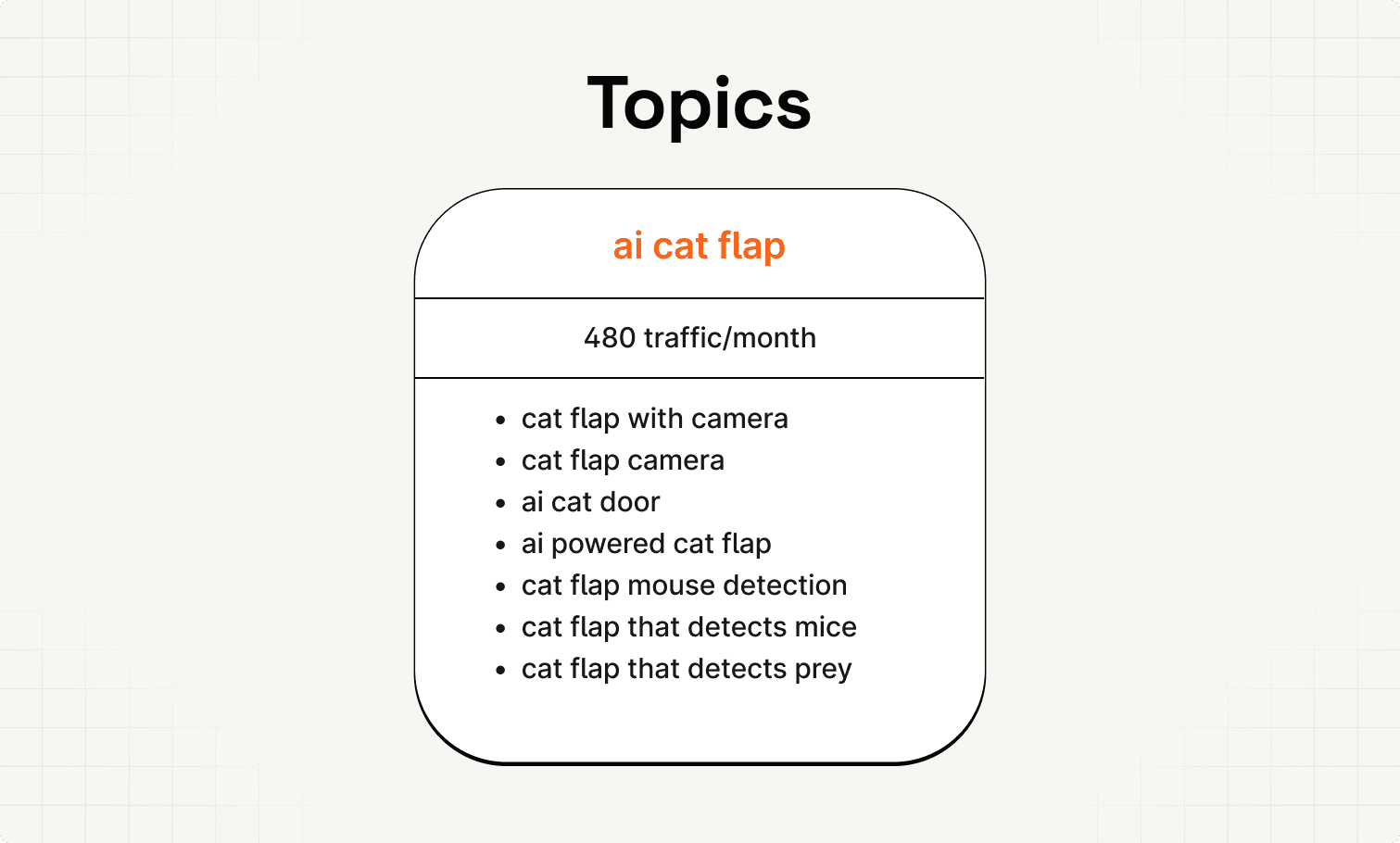
Step F - Doublecheck the Intent
It can easily happen that you go through this process and end up with one or more topics that don't exactly match the product focused intent.
To be clear, what we are trying to find is one or more topics that exactly lead to our product.
So when putting the topic into Google, you or your competitors landing page should come up.
For Flappie, this is the case!
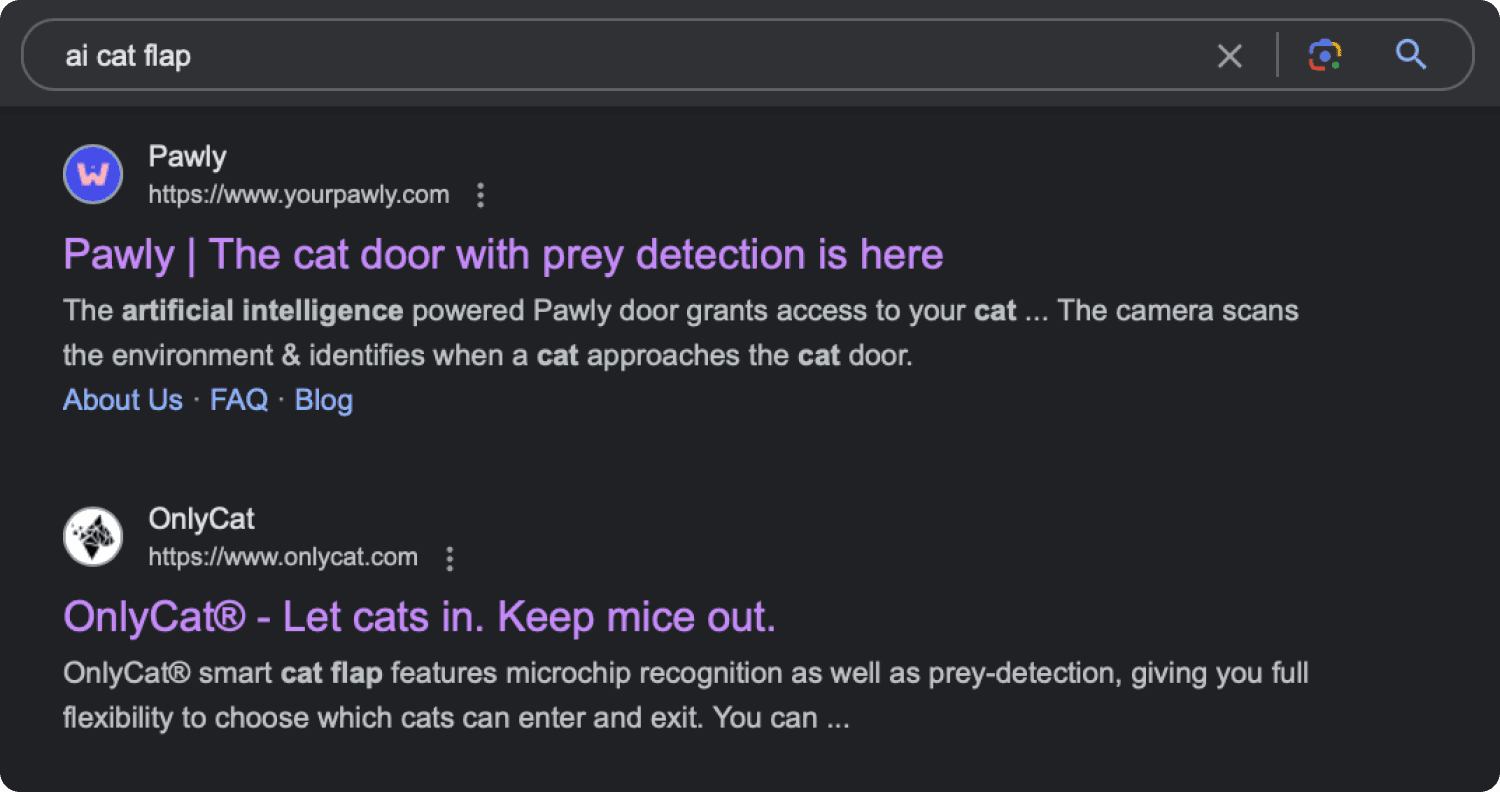
But let me give you an example of a topic that doesn't have the right intent: app controlled cat flap.

Here, Amazon products rank but neither Flappie nor their competitors.
So the intent is a little different and it's more a feature focused & thus maps to a feature page. More on that in the next chapter.
Before we move to actually optimising the landing page, let's take a look at the competitiveness.
The keywords/topic we want to optimise our landing page for, fall into the solution aware stage of the customer journey.
What do I mean by that?
The customer journey separates potential customers into distinct stages of awareness, from realising they have a problem to choosing a solution.
People in this solution aware stage know they have a problem and have seen a solution. But they aren’t aware of any specific brands or products.
Let's use Flappie as example.

For Flappie, people in the solution aware stage have a cat that brings home prey. They know there are cat flaps that prevent this. But they don't know any specific products or brands.
The question then is, what keywords are they using on Google to find products/brands?
Great question.
The thing is, it's not just one search term they are using.
For startups, there are 4 different perspectives we can take on finding these topics/keywords:
Product focused - People search for your product directly (e.g. cat flap with prey detection)
Feature focused - People search for a feature of your product (e.g. cat flap with app)
Solution focused - People search for a specific solution (e.g. cat flap for high prey drive cats)
Competitor focused - People know a competitor and are looking for alternatives

For optimising the landing page, we are only interested in the product focused topics.
But why?
Well, when people search for your product exactly, ideally your landing page ranks.
And what happens to the feature, solution & competitor focused topics?
As we've seen in the SEO Strategy chapter, the other topic types map to feature/solution pages and competitor pages. All will be covered in the next chapters.

Great!
Now let's look into my bulletproof way of finding the product focused topics/keywords.
Again, these are the terms people put into Google that describe your solution without any doubt. An example for Flappie could be "cat flap with prey detection".
If you follow the course, you'll realise that we covered this in the Keyword Research chapter already. Feel free to skip to step #2 if you know your product focused topic already.
Step A: Start by brainstorming potential keyword ideas that exactly describe your product. Add them to your list.
Step B: Use Google Search Console & select your landing page to find keywords you already rank for. Extend your list.
Step C: Use Google Keyword Planner to find keyword ideas based on your and your competitors landing page. Extend your list.
Step D: Use the aggregated keywords from step 1 - 3 as starting point in Google Keyword Planner to find more keywords - keywords in, keywords out! Also note down the search volume.
Step E: Cluster the list of keywords into topics by putting them into Google and checking if they have an overlap of 3+ urls.
Step F: Doublecheck the intent to make sure they are really product focused topics.
Follow along step by step.

Step A - Brainstorming
The goal here is to come up with a list of 10-15 potential search terms you would use to find your product.
Put yourself in the shoes of a potential person searching for it.
What are you asking Google that exactly describes your offering?
It shouldn't be too broad. Too narrow is fine.
For Flappie, the term cat flap would be too broad. It doesn't exactly describe the core of Flappie's offering.
But something like this is perfect.
cat flap that detects prey
cat flap that prevents cat from bringing home prey
cat flap with mice detection
smart cat flap
ai cat flap
cat flap with camera
You get the point!
But don't worry if you add too broad things by accident. We'll filter it out later.
Step B - Google Search Console
Google Search Console provides us with information on the keywords people use to find our landing page.
To find them, open Google Search Console & navigate to the pages tab.
Click on your landing page.

This enables the landing page as a filter option.
Now, switch to the queries tab and you'll see all keywords people use to find your landing page.
See if there's something you can add to your list.
Again, you are only searching for keywords that exactly describe your product.

For Flappie there are quite a few I haven't thought of so far.
They are in German but I’ll translate them for you.
cat flap with mice detection
cat flap with prey detection
cat door with mice detection
cat flap with mice detection
cat flap with prey detection
cat flap with chip and mice detection
These are great.
Add everything you find to your list.
If you only see branded searches, don’t worry.
Just move on.
Step C - Page based Keyword Ideas
Google Keyword Planner gives us keyword ideas based on a website url.
To find product focused keywords, we'll use our landing page as website url.
Navigate to Google Ads and open the Google Keyword Planner.
Select the Start with a website option and paste your landing page url in there.

Make sure to select the correct location, language & only this page.
Let's see Flappie as example. I will use the English version of their website so you can understand the suggested keywords.
Hit the Get results button.
You now have a list of keyword ideas.
Good stuff!
Add new keywords to your list.

Instead of your own landing page you can also add the landing page of your direct competitors.
Step D - Keywords In, Keywords Out
Fantastic, you should now have a list of keywords.
We'll now put them into Google Keyword Planner to find even more.
I call this keywords in, keywords out.
Use the start with keywords tab and add up to 10 keywords of your list from Steps 1-3 at a time.
Click get results to receive a list of keyword ideas.

Add everything that comes up and you think makes sense to your list.
Make sure to add the monthly search volume to all keywords. If you see a search term does not have any searches, remove it from the list.
Grow your list. Rather add too much than too little. We'll filter out in step 6 again.
For Flappie I am left with something like this.
cat flap with camera (50 searches/m)
cat flap camera (40 searches/m)
ai cat flap (140 searches/m)
ai cat door (70 searches/m)
ai powered cat flap (10 searches/m)
cat flap mouse detection (40 searches/m)
cat flap that detects mice (30 searches/m)
cat flap that detects prey (70 searches/m)
Great!
Step E - Cluster Keywords to Topics
So far we found a bunch of keywords that people put into Google.
But remember, topics are the new keywords.
We've seen that a topic is a cluster (=group) of keywords with the same intent. Meaning that people have the same intention when putting either of these keywords into Google.

The topic name (A) is thereby the keyword with the largest monthly search volume. It is also called the primary keyword.
The total monthly search volume of a topic (B) is the sum over all keywords. If you calculate the sum over all keywords on the left side, you'll see that it is 450.
The other keywords (C) are called cluster keywords.
So we need to cluster our list of keywords from steps 1-4 into topics.
But how?
It's simple - put the keywords into Google and see which ones have an overlap of 3+ urls.

If you feel lost, check the previous chapter on the relation of topics and keywords.
For Flappie, I am left with only one topic.

Step F - Doublecheck the Intent
It can easily happen that you go through this process and end up with one or more topics that don't exactly match the product focused intent.
To be clear, what we are trying to find is one or more topics that exactly lead to our product.
So when putting the topic into Google, you or your competitors landing page should come up.
For Flappie, this is the case!

But let me give you an example of a topic that doesn't have the right intent: app controlled cat flap.

Here, Amazon products rank but neither Flappie nor their competitors.
So the intent is a little different and it's more a feature focused & thus maps to a feature page. More on that in the next chapter.
Before we move to actually optimising the landing page, let's take a look at the competitiveness.
The keywords/topic we want to optimise our landing page for, fall into the solution aware stage of the customer journey.
What do I mean by that?
The customer journey separates potential customers into distinct stages of awareness, from realising they have a problem to choosing a solution.
People in this solution aware stage know they have a problem and have seen a solution. But they aren’t aware of any specific brands or products.
Let's use Flappie as example.

For Flappie, people in the solution aware stage have a cat that brings home prey. They know there are cat flaps that prevent this. But they don't know any specific products or brands.
The question then is, what keywords are they using on Google to find products/brands?
Great question.
The thing is, it's not just one search term they are using.
For startups, there are 4 different perspectives we can take on finding these topics/keywords:
Product focused - People search for your product directly (e.g. cat flap with prey detection)
Feature focused - People search for a feature of your product (e.g. cat flap with app)
Solution focused - People search for a specific solution (e.g. cat flap for high prey drive cats)
Competitor focused - People know a competitor and are looking for alternatives

For optimising the landing page, we are only interested in the product focused topics.
But why?
Well, when people search for your product exactly, ideally your landing page ranks.
And what happens to the feature, solution & competitor focused topics?
As we've seen in the SEO Strategy chapter, the other topic types map to feature/solution pages and competitor pages. All will be covered in the next chapters.

Great!
Now let's look into my bulletproof way of finding the product focused topics/keywords.
Again, these are the terms people put into Google that describe your solution without any doubt. An example for Flappie could be "cat flap with prey detection".
If you follow the course, you'll realise that we covered this in the Keyword Research chapter already. Feel free to skip to step #2 if you know your product focused topic already.
Step A: Start by brainstorming potential keyword ideas that exactly describe your product. Add them to your list.
Step B: Use Google Search Console & select your landing page to find keywords you already rank for. Extend your list.
Step C: Use Google Keyword Planner to find keyword ideas based on your and your competitors landing page. Extend your list.
Step D: Use the aggregated keywords from step 1 - 3 as starting point in Google Keyword Planner to find more keywords - keywords in, keywords out! Also note down the search volume.
Step E: Cluster the list of keywords into topics by putting them into Google and checking if they have an overlap of 3+ urls.
Step F: Doublecheck the intent to make sure they are really product focused topics.
Follow along step by step.

Step A - Brainstorming
The goal here is to come up with a list of 10-15 potential search terms you would use to find your product.
Put yourself in the shoes of a potential person searching for it.
What are you asking Google that exactly describes your offering?
It shouldn't be too broad. Too narrow is fine.
For Flappie, the term cat flap would be too broad. It doesn't exactly describe the core of Flappie's offering.
But something like this is perfect.
cat flap that detects prey
cat flap that prevents cat from bringing home prey
cat flap with mice detection
smart cat flap
ai cat flap
cat flap with camera
You get the point!
But don't worry if you add too broad things by accident. We'll filter it out later.
Step B - Google Search Console
Google Search Console provides us with information on the keywords people use to find our landing page.
To find them, open Google Search Console & navigate to the pages tab.
Click on your landing page.

This enables the landing page as a filter option.
Now, switch to the queries tab and you'll see all keywords people use to find your landing page.
See if there's something you can add to your list.
Again, you are only searching for keywords that exactly describe your product.

For Flappie there are quite a few I haven't thought of so far.
They are in German but I’ll translate them for you.
cat flap with mice detection
cat flap with prey detection
cat door with mice detection
cat flap with mice detection
cat flap with prey detection
cat flap with chip and mice detection
These are great.
Add everything you find to your list.
If you only see branded searches, don’t worry.
Just move on.
Step C - Page based Keyword Ideas
Google Keyword Planner gives us keyword ideas based on a website url.
To find product focused keywords, we'll use our landing page as website url.
Navigate to Google Ads and open the Google Keyword Planner.
Select the Start with a website option and paste your landing page url in there.

Make sure to select the correct location, language & only this page.
Let's see Flappie as example. I will use the English version of their website so you can understand the suggested keywords.
Hit the Get results button.
You now have a list of keyword ideas.
Good stuff!
Add new keywords to your list.

Instead of your own landing page you can also add the landing page of your direct competitors.
Step D - Keywords In, Keywords Out
Fantastic, you should now have a list of keywords.
We'll now put them into Google Keyword Planner to find even more.
I call this keywords in, keywords out.
Use the start with keywords tab and add up to 10 keywords of your list from Steps 1-3 at a time.
Click get results to receive a list of keyword ideas.

Add everything that comes up and you think makes sense to your list.
Make sure to add the monthly search volume to all keywords. If you see a search term does not have any searches, remove it from the list.
Grow your list. Rather add too much than too little. We'll filter out in step 6 again.
For Flappie I am left with something like this.
cat flap with camera (50 searches/m)
cat flap camera (40 searches/m)
ai cat flap (140 searches/m)
ai cat door (70 searches/m)
ai powered cat flap (10 searches/m)
cat flap mouse detection (40 searches/m)
cat flap that detects mice (30 searches/m)
cat flap that detects prey (70 searches/m)
Great!
Step E - Cluster Keywords to Topics
So far we found a bunch of keywords that people put into Google.
But remember, topics are the new keywords.
We've seen that a topic is a cluster (=group) of keywords with the same intent. Meaning that people have the same intention when putting either of these keywords into Google.

The topic name (A) is thereby the keyword with the largest monthly search volume. It is also called the primary keyword.
The total monthly search volume of a topic (B) is the sum over all keywords. If you calculate the sum over all keywords on the left side, you'll see that it is 450.
The other keywords (C) are called cluster keywords.
So we need to cluster our list of keywords from steps 1-4 into topics.
But how?
It's simple - put the keywords into Google and see which ones have an overlap of 3+ urls.

If you feel lost, check the previous chapter on the relation of topics and keywords.
For Flappie, I am left with only one topic.

Step F - Doublecheck the Intent
It can easily happen that you go through this process and end up with one or more topics that don't exactly match the product focused intent.
To be clear, what we are trying to find is one or more topics that exactly lead to our product.
So when putting the topic into Google, you or your competitors landing page should come up.
For Flappie, this is the case!

But let me give you an example of a topic that doesn't have the right intent: app controlled cat flap.

Here, Amazon products rank but neither Flappie nor their competitors.
So the intent is a little different and it's more a feature focused & thus maps to a feature page. More on that in the next chapter.
Before we move to actually optimising the landing page, let's take a look at the competitiveness.
Step #2 - Check the Competitiveness
So we know the topic people use to find our product. But we don't know how difficult it might be to rank for it.
And the thing is, you never know 100% beforehand. But the following 2 steps can give you a good sense of how hard it will be.
Using this information we can also double check the topic we found and see if it actually is the right one.
So let's get started
Find your Domain Authority
The Domain Authority is an estimate of how trustworthy your website is. We've discussed this in a previous chapter so I'll not go into details.
To find it, you can use Ahrefs free Domain Authority checker. But I recommend to set up Ahrefs webmaster tool. It's also 100% free and gives you a lot more functionalities.
For Flappie, we find a Domain Authority (=Domain Rating) of 29.

Great.
Find the Domain Authority of the Top 10 Pages
We now want to get a feel for how competitive the topic we found in #1 - Topical Keyword Research actually is.
To do this, search for the product focused topic on Google and get the Domain Authority for all of the top 10 results.
Here I did it for the top 3 of Flappie so you get an idea.
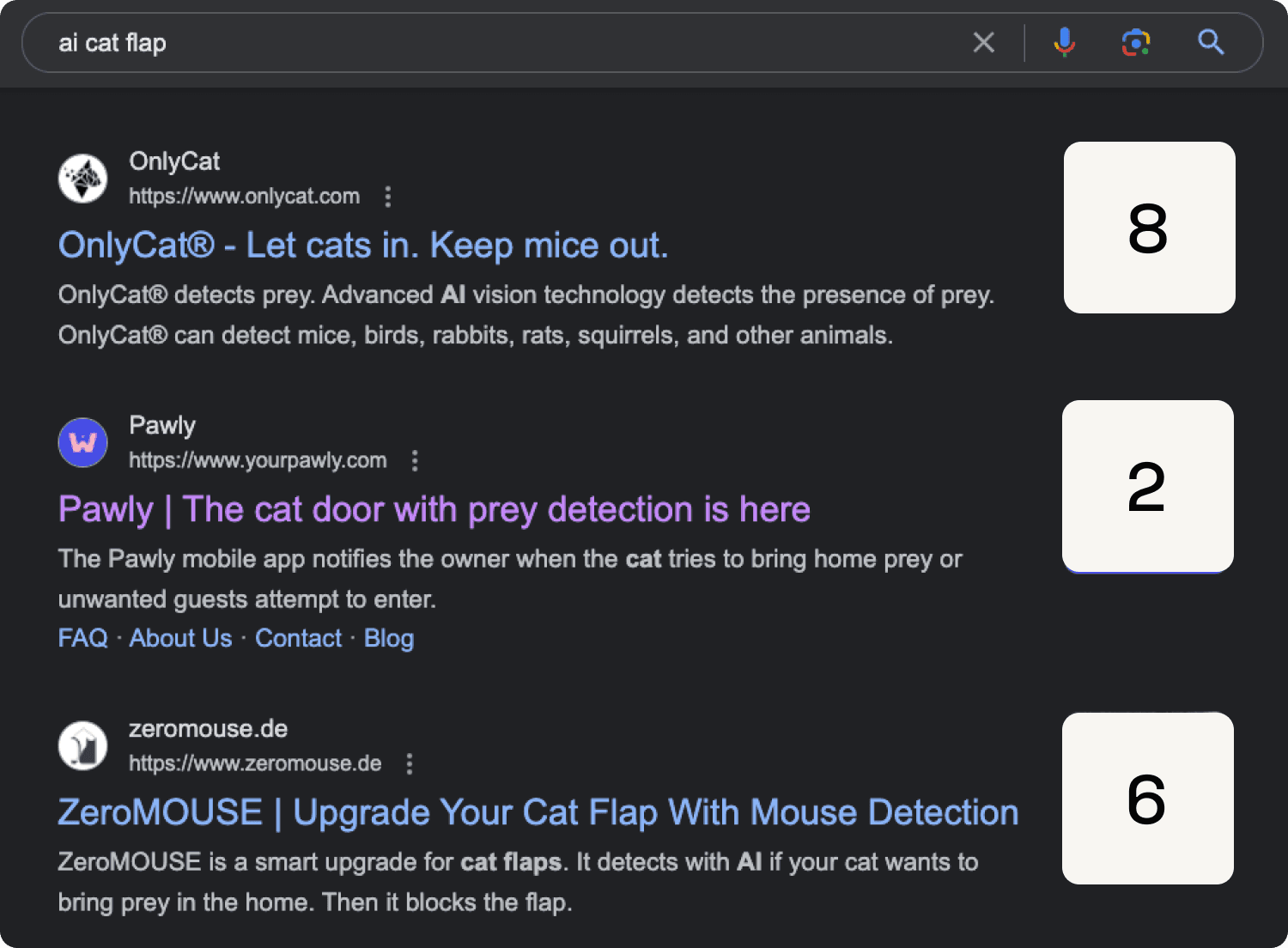
Understand the Competition
You can see that all of the ranking pages in our example have way lower Domain Authority than Flappie. So it will not be hard for Flappie to compete.
But what if the pages were more authoritative?
Well, it depends.
If you see that at least some of the top 10 results have a low Domain Authority (20-40) or it's just a feature of a bigger product, your chances of ranking are quite good. Just focus on building Topical Authority for the product focused topic and be patient.
But what if you see that all of the top 10 results have a high Domain Authority of ~60-70+? Well, then it's a very competitive topic. Your chances of ranking are low.
However, the thing is, maybe you just found the wrong topic? Ask yourself - who are you targeting and how do you differentiate from existing products?
Run again through the process of finding topics in #1. This way you maybe come up with a product focused topic that is more niche and less competitive.
Often there is one which can help you get very high intent traffic early on.
But what if not? What if you’re actually doing the exact same thing as existing players? Or nobody searches for the way your product differentiates?
Well, it means that the topic you found is indeed the right one. But it’s just very hard to rank.
All good. No worries.
Enough other ways to get traffic early on. With time you’ll build the authority to rank.
So we know the topic people use to find our product. But we don't know how difficult it might be to rank for it.
And the thing is, you never know 100% beforehand. But the following 2 steps can give you a good sense of how hard it will be.
Using this information we can also double check the topic we found and see if it actually is the right one.
So let's get started
Find your Domain Authority
The Domain Authority is an estimate of how trustworthy your website is. We've discussed this in a previous chapter so I'll not go into details.
To find it, you can use Ahrefs free Domain Authority checker. But I recommend to set up Ahrefs webmaster tool. It's also 100% free and gives you a lot more functionalities.
For Flappie, we find a Domain Authority (=Domain Rating) of 29.

Great.
Find the Domain Authority of the Top 10 Pages
We now want to get a feel for how competitive the topic we found in #1 - Topical Keyword Research actually is.
To do this, search for the product focused topic on Google and get the Domain Authority for all of the top 10 results.
Here I did it for the top 3 of Flappie so you get an idea.

Understand the Competition
You can see that all of the ranking pages in our example have way lower Domain Authority than Flappie. So it will not be hard for Flappie to compete.
But what if the pages were more authoritative?
Well, it depends.
If you see that at least some of the top 10 results have a low Domain Authority (20-40) or it's just a feature of a bigger product, your chances of ranking are quite good. Just focus on building Topical Authority for the product focused topic and be patient.
But what if you see that all of the top 10 results have a high Domain Authority of ~60-70+? Well, then it's a very competitive topic. Your chances of ranking are low.
However, the thing is, maybe you just found the wrong topic? Ask yourself - who are you targeting and how do you differentiate from existing products?
Run again through the process of finding topics in #1. This way you maybe come up with a product focused topic that is more niche and less competitive.
Often there is one which can help you get very high intent traffic early on.
But what if not? What if you’re actually doing the exact same thing as existing players? Or nobody searches for the way your product differentiates?
Well, it means that the topic you found is indeed the right one. But it’s just very hard to rank.
All good. No worries.
Enough other ways to get traffic early on. With time you’ll build the authority to rank.
So we know the topic people use to find our product. But we don't know how difficult it might be to rank for it.
And the thing is, you never know 100% beforehand. But the following 2 steps can give you a good sense of how hard it will be.
Using this information we can also double check the topic we found and see if it actually is the right one.
So let's get started
Find your Domain Authority
The Domain Authority is an estimate of how trustworthy your website is. We've discussed this in a previous chapter so I'll not go into details.
To find it, you can use Ahrefs free Domain Authority checker. But I recommend to set up Ahrefs webmaster tool. It's also 100% free and gives you a lot more functionalities.
For Flappie, we find a Domain Authority (=Domain Rating) of 29.

Great.
Find the Domain Authority of the Top 10 Pages
We now want to get a feel for how competitive the topic we found in #1 - Topical Keyword Research actually is.
To do this, search for the product focused topic on Google and get the Domain Authority for all of the top 10 results.
Here I did it for the top 3 of Flappie so you get an idea.

Understand the Competition
You can see that all of the ranking pages in our example have way lower Domain Authority than Flappie. So it will not be hard for Flappie to compete.
But what if the pages were more authoritative?
Well, it depends.
If you see that at least some of the top 10 results have a low Domain Authority (20-40) or it's just a feature of a bigger product, your chances of ranking are quite good. Just focus on building Topical Authority for the product focused topic and be patient.
But what if you see that all of the top 10 results have a high Domain Authority of ~60-70+? Well, then it's a very competitive topic. Your chances of ranking are low.
However, the thing is, maybe you just found the wrong topic? Ask yourself - who are you targeting and how do you differentiate from existing products?
Run again through the process of finding topics in #1. This way you maybe come up with a product focused topic that is more niche and less competitive.
Often there is one which can help you get very high intent traffic early on.
But what if not? What if you’re actually doing the exact same thing as existing players? Or nobody searches for the way your product differentiates?
Well, it means that the topic you found is indeed the right one. But it’s just very hard to rank.
All good. No worries.
Enough other ways to get traffic early on. With time you’ll build the authority to rank.
Step #3 - Optimise the Page around the Topic (On-Page SEO)
We’ve previously seen that Google uses Keywords to understand our content.
Check their “How Search Works” page for more details.
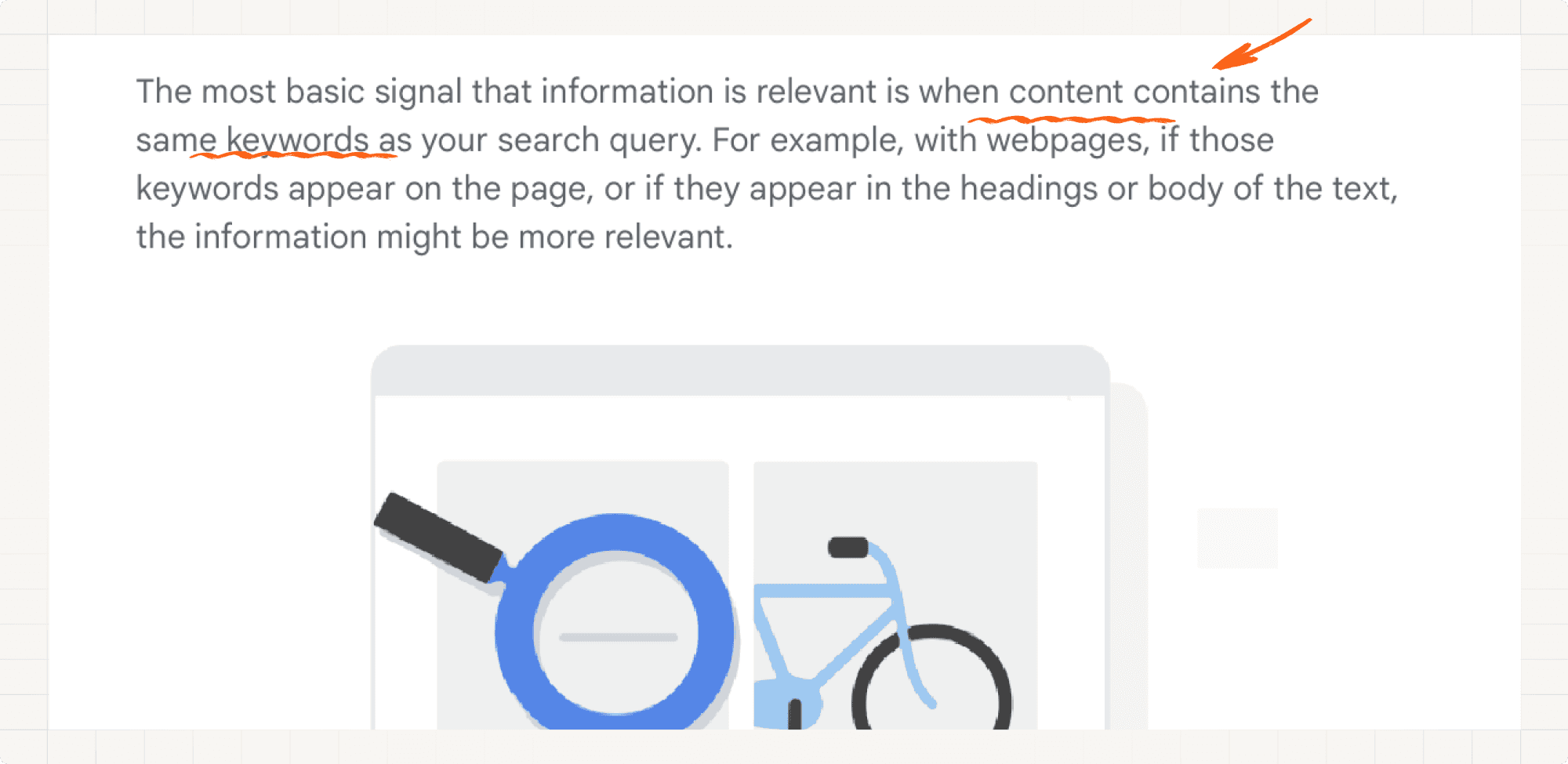
But this doesn’t mean you should spam the keyword.
Please don’t do this.
“Just think: when you search for “dogs”, you likely don’t want a page with the word “dogs” on it hundreds of times.” ~ Google
To give you a better idea, here is a Keyword Stuffing example by Google.

So, where should we add keywords and which ones?
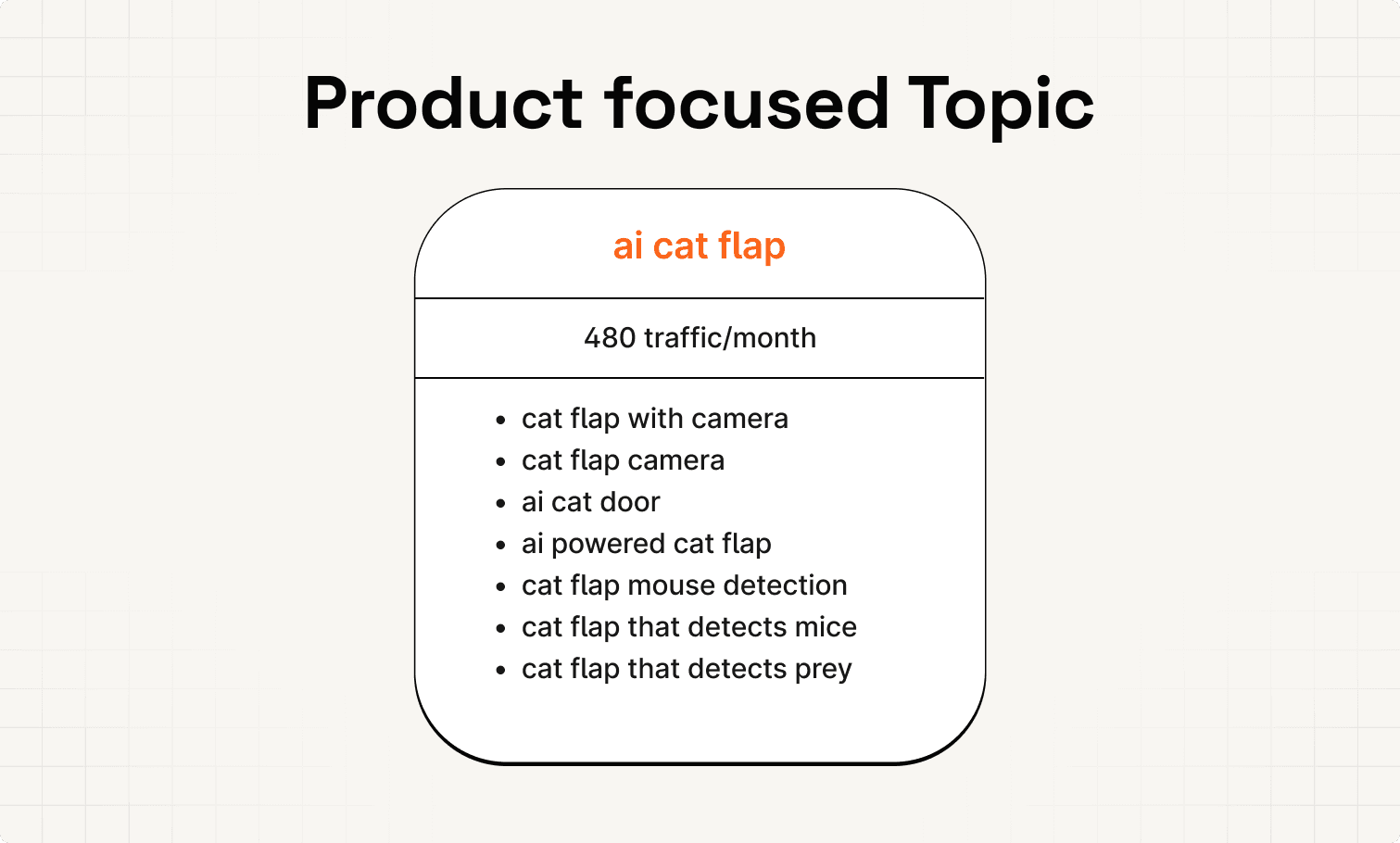
Well, you should add the product focused topic name (ai cat flap) in the following places:
H1, H2 or H3
First 150 words
Title Tag
Meta Description
H1, H2 or H3
H1, H2, H3 are abbreviations for Heading 1, Heading 2 and Heading 3.
If you’re non technical, this is how you logically structure your website into main heading (H1), subheadings (H2), and sub-subheadhings (H3).
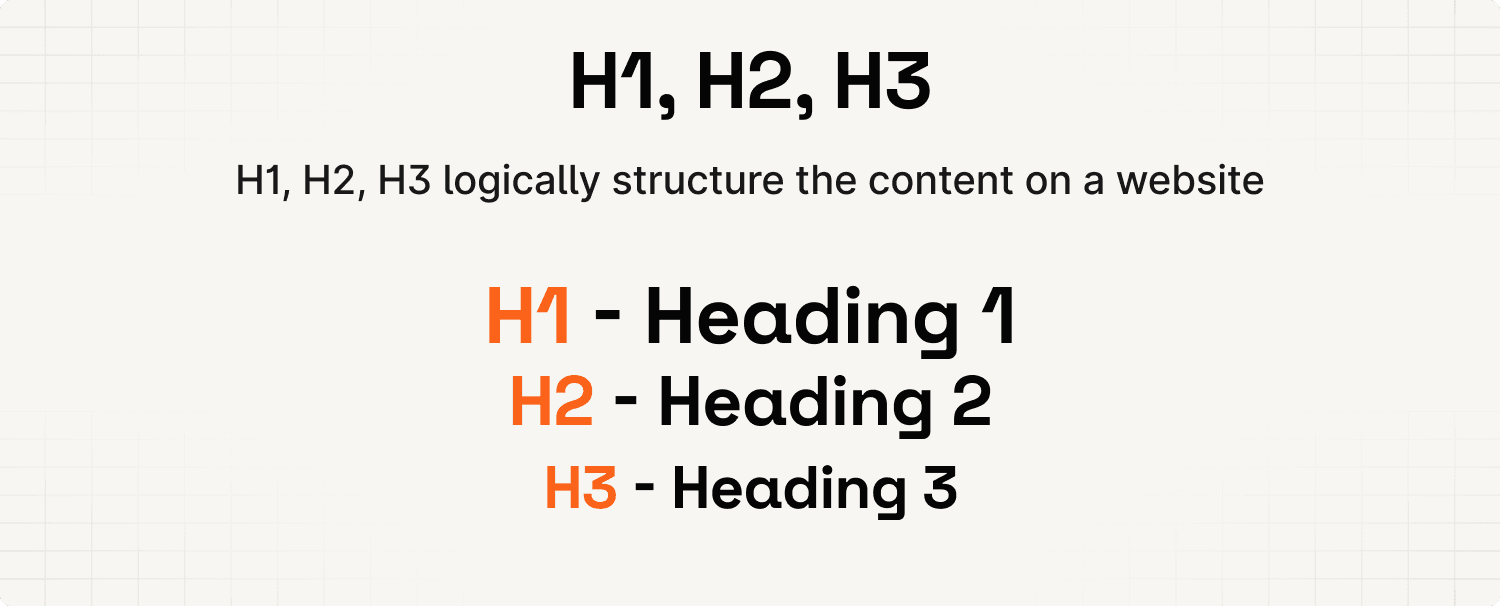
As Google states about keywords: “If they appear in the headings or body of the text, the information might be more relevant”.
Thus, the H1 is the most relevant place to put a keyword. Followed by H2, H3 & finally other text. But this doesn’t mean you should always put the topic into your H1!
But why not?
Well, the most important aspect of the landing page is to convert visitors to customers. For that, you need a great copy. Just look at practice.do’s landing page.
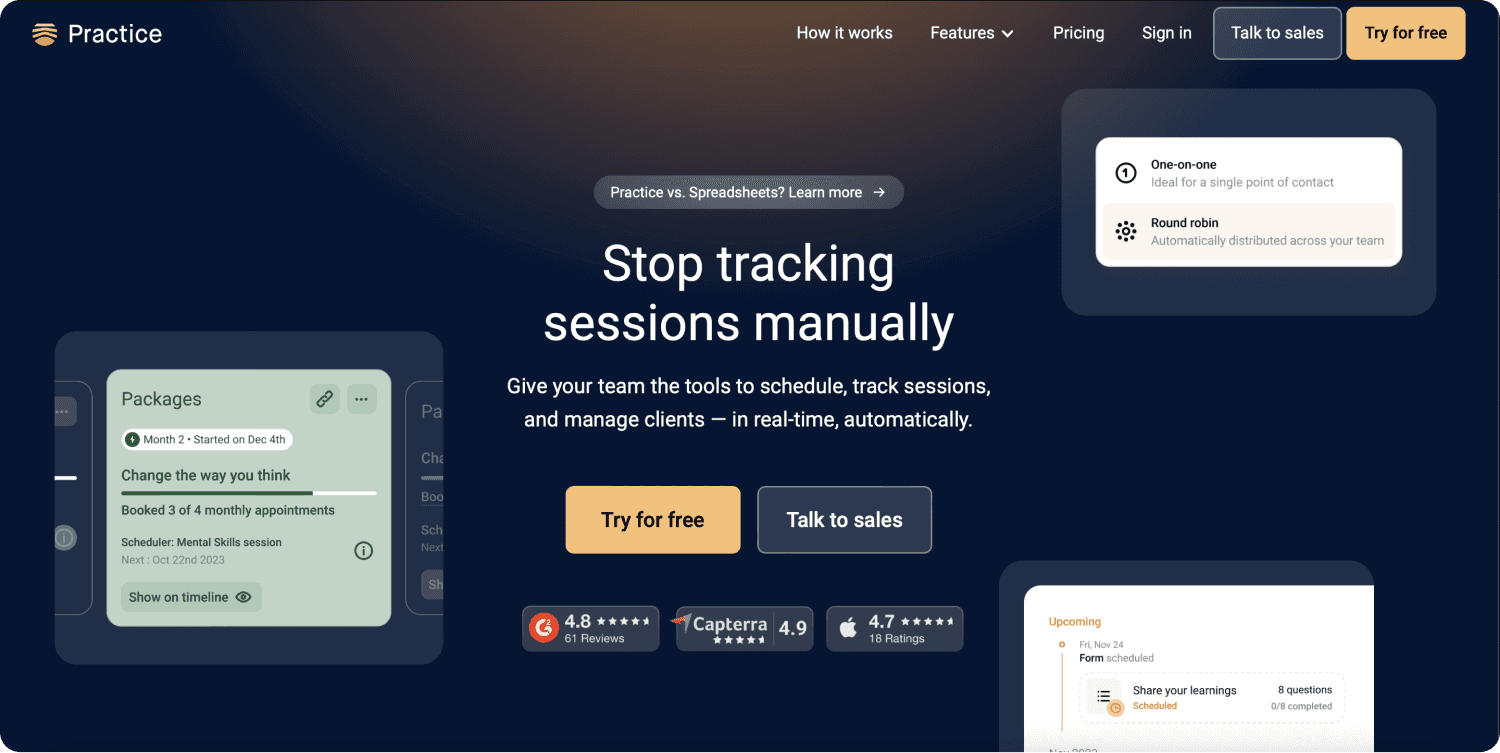
This is great copywriting.
So I generally think it’s just fine if you add the topic into one of the H2s.
First 150 words
According to Backlinko, Google pays more attention to the first 150 words of a page. So, if possible, include the topic name here as well.
But again, focus on a great copy. Then think about adding the topic keyword.
A great & sneaky way to do this is to utilise a badge above your heading. Here’s an example of HeadshotPro doing that.
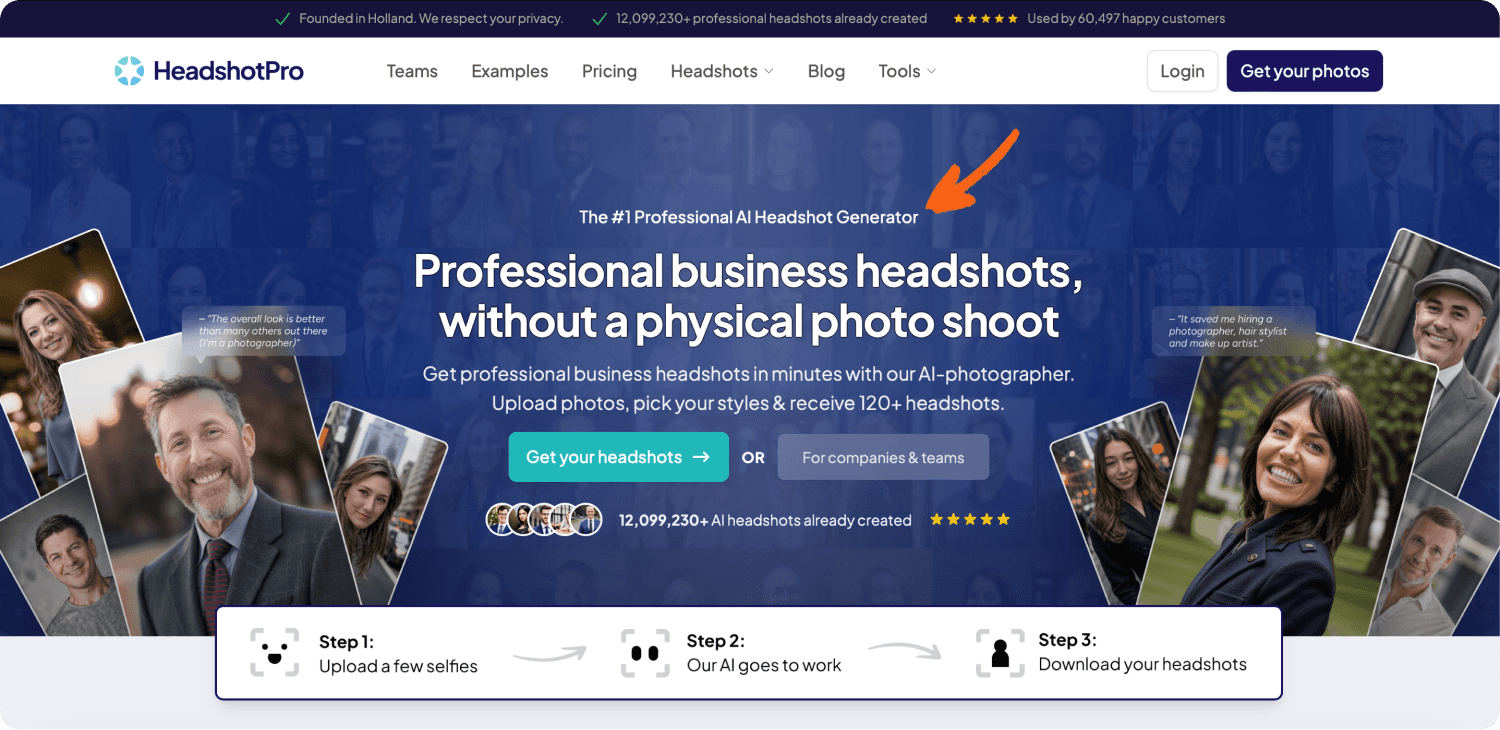
Title Tag
The title tag is the title you see in the preview of a page.
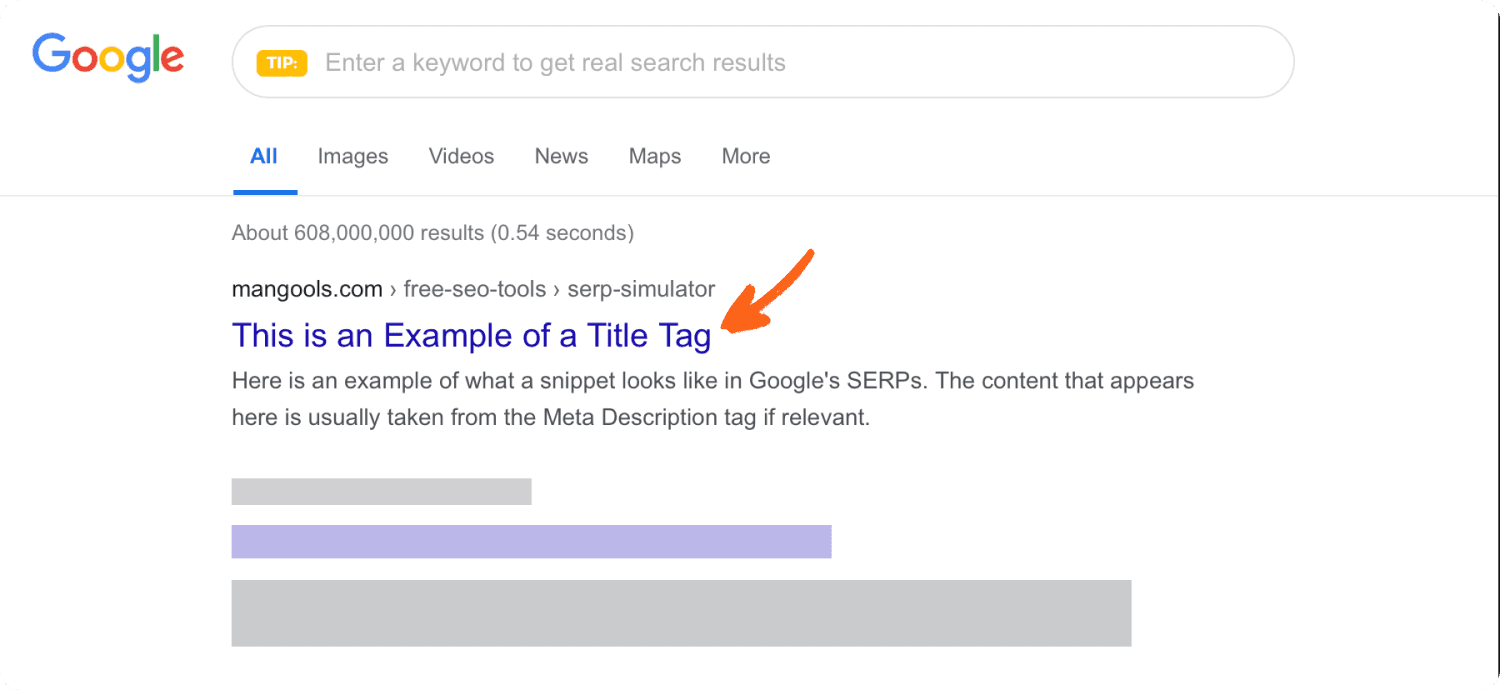
Add the topic name to the title tag.
You want to put your keyword in the front of your title tag whenever possible. This is called front loading.
But you don’t just want to have the topic keyword as title tag. You want to add other things to it as well. Things that make the people click.
To improve the share of people clicking on your page (=Click Through Rate, CTR), make your title tag irresistible and stand out.
An example for the topic “seo for startups” could be:

Bet you would click on that!
The length of the title tag should not be too long. Use this tool to check how it’d look like.
Meta Description
The meta description is the description you see in the preview of a page.

Google sometimes automatically replaces it with other parts of your content. This is nothing to worry about.
Generally the meta description is not a ranking factor.
But if you have the keyword the user searches for in the meta description, Google highlights it.

This increases the chance the user clicks on your result over others.
Add Cluster Keywords
Besides the main topic name, also add the cluster keywords in other places of the content where it makes sense.
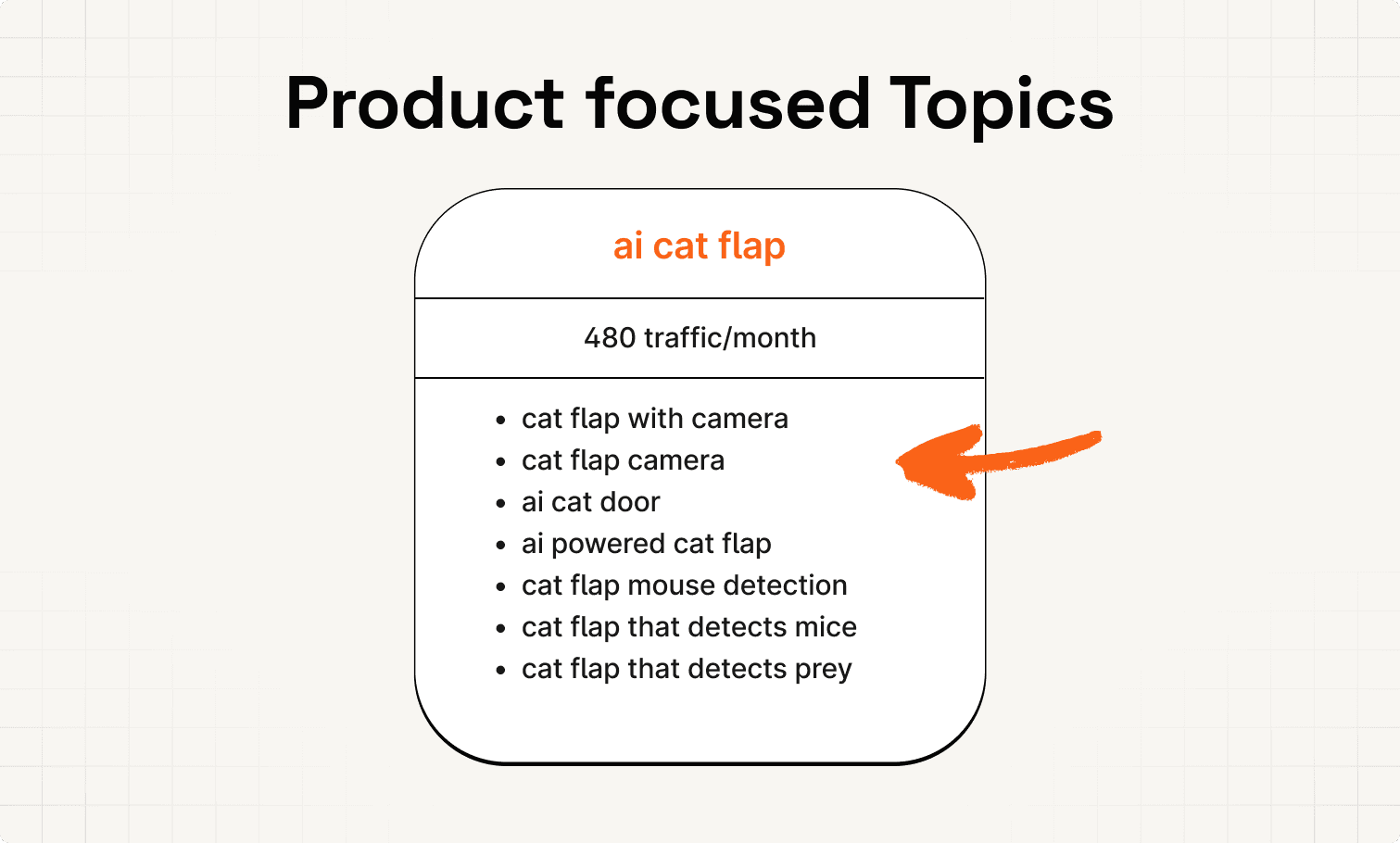
Some people call the cluster keywords LSI keywords. If you ever hear somebody say it, now you know what it is;)
Don’t overdo it however. Only add the cluster keywords where it makes sense.
Remember: “Just think: when you search for “dogs”, you likely don’t want a page with the word “dogs” on it hundreds of times.” ~ Google
We’ve previously seen that Google uses Keywords to understand our content.
Check their “How Search Works” page for more details.

But this doesn’t mean you should spam the keyword.
Please don’t do this.
“Just think: when you search for “dogs”, you likely don’t want a page with the word “dogs” on it hundreds of times.” ~ Google
To give you a better idea, here is a Keyword Stuffing example by Google.

So, where should we add keywords and which ones?

Well, you should add the product focused topic name (ai cat flap) in the following places:
H1, H2 or H3
First 150 words
Title Tag
Meta Description
H1, H2 or H3
H1, H2, H3 are abbreviations for Heading 1, Heading 2 and Heading 3.
If you’re non technical, this is how you logically structure your website into main heading (H1), subheadings (H2), and sub-subheadhings (H3).

As Google states about keywords: “If they appear in the headings or body of the text, the information might be more relevant”.
Thus, the H1 is the most relevant place to put a keyword. Followed by H2, H3 & finally other text. But this doesn’t mean you should always put the topic into your H1!
But why not?
Well, the most important aspect of the landing page is to convert visitors to customers. For that, you need a great copy. Just look at practice.do’s landing page.

This is great copywriting.
So I generally think it’s just fine if you add the topic into one of the H2s.
First 150 words
According to Backlinko, Google pays more attention to the first 150 words of a page. So, if possible, include the topic name here as well.
But again, focus on a great copy. Then think about adding the topic keyword.
A great & sneaky way to do this is to utilise a badge above your heading. Here’s an example of HeadshotPro doing that.

Title Tag
The title tag is the title you see in the preview of a page.

Add the topic name to the title tag.
You want to put your keyword in the front of your title tag whenever possible. This is called front loading.
But you don’t just want to have the topic keyword as title tag. You want to add other things to it as well. Things that make the people click.
To improve the share of people clicking on your page (=Click Through Rate, CTR), make your title tag irresistible and stand out.
An example for the topic “seo for startups” could be:

Bet you would click on that!
The length of the title tag should not be too long. Use this tool to check how it’d look like.
Meta Description
The meta description is the description you see in the preview of a page.

Google sometimes automatically replaces it with other parts of your content. This is nothing to worry about.
Generally the meta description is not a ranking factor.
But if you have the keyword the user searches for in the meta description, Google highlights it.

This increases the chance the user clicks on your result over others.
Add Cluster Keywords
Besides the main topic name, also add the cluster keywords in other places of the content where it makes sense.

Some people call the cluster keywords LSI keywords. If you ever hear somebody say it, now you know what it is;)
Don’t overdo it however. Only add the cluster keywords where it makes sense.
Remember: “Just think: when you search for “dogs”, you likely don’t want a page with the word “dogs” on it hundreds of times.” ~ Google
We’ve previously seen that Google uses Keywords to understand our content.
Check their “How Search Works” page for more details.

But this doesn’t mean you should spam the keyword.
Please don’t do this.
“Just think: when you search for “dogs”, you likely don’t want a page with the word “dogs” on it hundreds of times.” ~ Google
To give you a better idea, here is a Keyword Stuffing example by Google.

So, where should we add keywords and which ones?

Well, you should add the product focused topic name (ai cat flap) in the following places:
H1, H2 or H3
First 150 words
Title Tag
Meta Description
H1, H2 or H3
H1, H2, H3 are abbreviations for Heading 1, Heading 2 and Heading 3.
If you’re non technical, this is how you logically structure your website into main heading (H1), subheadings (H2), and sub-subheadhings (H3).

As Google states about keywords: “If they appear in the headings or body of the text, the information might be more relevant”.
Thus, the H1 is the most relevant place to put a keyword. Followed by H2, H3 & finally other text. But this doesn’t mean you should always put the topic into your H1!
But why not?
Well, the most important aspect of the landing page is to convert visitors to customers. For that, you need a great copy. Just look at practice.do’s landing page.

This is great copywriting.
So I generally think it’s just fine if you add the topic into one of the H2s.
First 150 words
According to Backlinko, Google pays more attention to the first 150 words of a page. So, if possible, include the topic name here as well.
But again, focus on a great copy. Then think about adding the topic keyword.
A great & sneaky way to do this is to utilise a badge above your heading. Here’s an example of HeadshotPro doing that.

Title Tag
The title tag is the title you see in the preview of a page.

Add the topic name to the title tag.
You want to put your keyword in the front of your title tag whenever possible. This is called front loading.
But you don’t just want to have the topic keyword as title tag. You want to add other things to it as well. Things that make the people click.
To improve the share of people clicking on your page (=Click Through Rate, CTR), make your title tag irresistible and stand out.
An example for the topic “seo for startups” could be:

Bet you would click on that!
The length of the title tag should not be too long. Use this tool to check how it’d look like.
Meta Description
The meta description is the description you see in the preview of a page.

Google sometimes automatically replaces it with other parts of your content. This is nothing to worry about.
Generally the meta description is not a ranking factor.
But if you have the keyword the user searches for in the meta description, Google highlights it.

This increases the chance the user clicks on your result over others.
Add Cluster Keywords
Besides the main topic name, also add the cluster keywords in other places of the content where it makes sense.

Some people call the cluster keywords LSI keywords. If you ever hear somebody say it, now you know what it is;)
Don’t overdo it however. Only add the cluster keywords where it makes sense.
Remember: “Just think: when you search for “dogs”, you likely don’t want a page with the word “dogs” on it hundreds of times.” ~ Google
Step #4 - Fulfil Intent & Convert the User
If everything goes well, you rank for the topic, the user saw your irresistible title tag and clicked.
We got him! Let’s go 🚀.
But now the hard part actually starts. As soon as you have the user on your page you have to keep them there. And win them as customer.
We don’t want them to leave our page!

This is arguably just as hard as getting them on our page!
Think about the last time you made a buying decision. Did you directly make a decision off the first tab you opened?
Most likely not.
If I had to guess, you probably evaluated a variety of options, checked their features & solution pages, looked at the reviews, went back & forth to finally make a purchase.
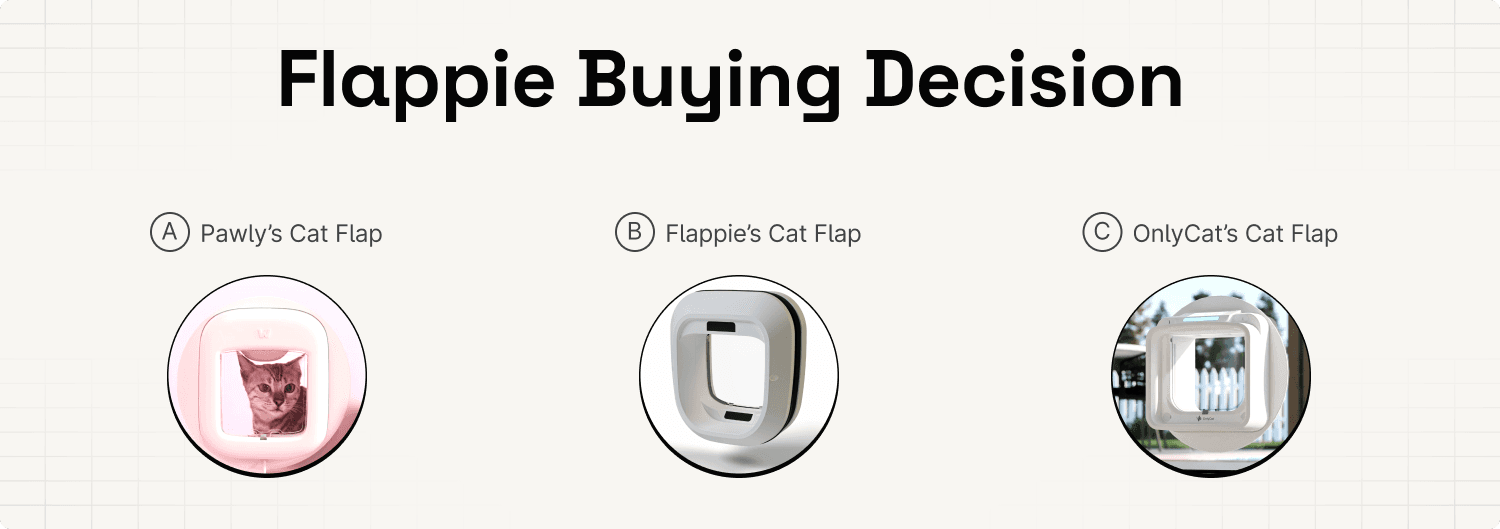
The same thing applies with people visiting your landing page.
So, you have to show them what you offer and why it is better than the alternatives. This is mostly design, UX and copywriting work. All of it is out of scope for this course.
But a great way to get started is to analyse the elements competitors have on their page.
I like to use Figma with the html to design plugin or the Chrome extension for that.
If everything goes well, you rank for the topic, the user saw your irresistible title tag and clicked.
We got him! Let’s go 🚀.
But now the hard part actually starts. As soon as you have the user on your page you have to keep them there. And win them as customer.
We don’t want them to leave our page!

This is arguably just as hard as getting them on our page!
Think about the last time you made a buying decision. Did you directly make a decision off the first tab you opened?
Most likely not.
If I had to guess, you probably evaluated a variety of options, checked their features & solution pages, looked at the reviews, went back & forth to finally make a purchase.

The same thing applies with people visiting your landing page.
So, you have to show them what you offer and why it is better than the alternatives. This is mostly design, UX and copywriting work. All of it is out of scope for this course.
But a great way to get started is to analyse the elements competitors have on their page.
I like to use Figma with the html to design plugin or the Chrome extension for that.
If everything goes well, you rank for the topic, the user saw your irresistible title tag and clicked.
We got him! Let’s go 🚀.
But now the hard part actually starts. As soon as you have the user on your page you have to keep them there. And win them as customer.
We don’t want them to leave our page!

This is arguably just as hard as getting them on our page!
Think about the last time you made a buying decision. Did you directly make a decision off the first tab you opened?
Most likely not.
If I had to guess, you probably evaluated a variety of options, checked their features & solution pages, looked at the reviews, went back & forth to finally make a purchase.

The same thing applies with people visiting your landing page.
So, you have to show them what you offer and why it is better than the alternatives. This is mostly design, UX and copywriting work. All of it is out of scope for this course.
But a great way to get started is to analyse the elements competitors have on their page.
I like to use Figma with the html to design plugin or the Chrome extension for that.
Step #5 - Fulfil Technical Requirements
There are only a few technical aspects I’d like to mention: Page Speed & Responsiveness
Page Speed is the amount of time it takes your webpage to fully load.
Responsiveness is the ability of your website to adjust its layout and content to different screen sizes and devices.
Google does evaluate these aspects. They are generally referred to as Core Web Vitals.
Google Search Console tells you exactly how you perform across all your pages.

Head to the Core Web Vitals tab and see the performance for Mobile and on Desktop. But if you’re using the newer website builders like Webflow or Framer this should be all good.
But I wouldn’t stress too much about this.
Graphite found that the Core Web Vitals actually have low direct impact on ranking.
Google themselves state that “when all things are relatively equal, content that people will find more accessible may perform better”.
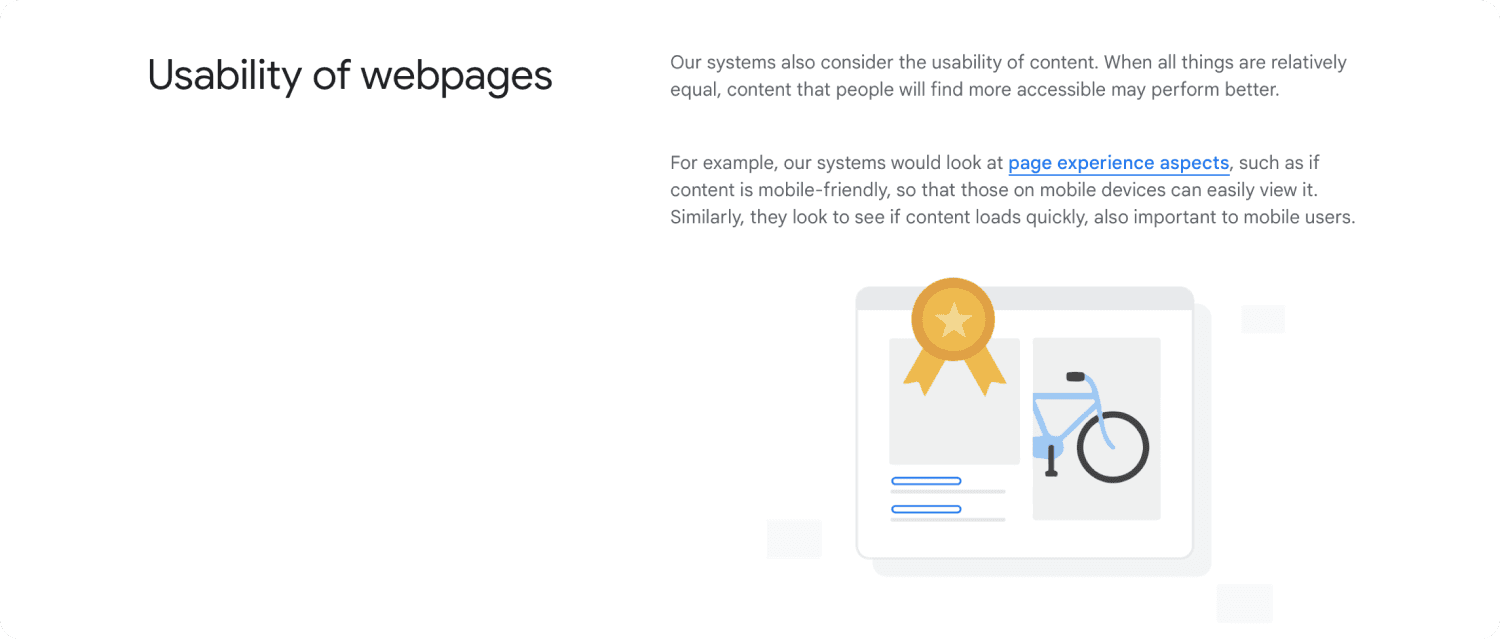
That’s a lot of "if" and "may" in my opinion.
But what does matter from my experience is how the user interacts with your page.
If a person get’s annoyed because your site loads for 4 seconds, hits back and clicks on your competitor.
Well, that’s a bad sign and a lost lead.
We want to avoid this.
So just make sure the page loads quickly and is responsive (=can be accessed from smartphones).
There are only a few technical aspects I’d like to mention: Page Speed & Responsiveness
Page Speed is the amount of time it takes your webpage to fully load.
Responsiveness is the ability of your website to adjust its layout and content to different screen sizes and devices.
Google does evaluate these aspects. They are generally referred to as Core Web Vitals.
Google Search Console tells you exactly how you perform across all your pages.

Head to the Core Web Vitals tab and see the performance for Mobile and on Desktop. But if you’re using the newer website builders like Webflow or Framer this should be all good.
But I wouldn’t stress too much about this.
Graphite found that the Core Web Vitals actually have low direct impact on ranking.
Google themselves state that “when all things are relatively equal, content that people will find more accessible may perform better”.

That’s a lot of "if" and "may" in my opinion.
But what does matter from my experience is how the user interacts with your page.
If a person get’s annoyed because your site loads for 4 seconds, hits back and clicks on your competitor.
Well, that’s a bad sign and a lost lead.
We want to avoid this.
So just make sure the page loads quickly and is responsive (=can be accessed from smartphones).
There are only a few technical aspects I’d like to mention: Page Speed & Responsiveness
Page Speed is the amount of time it takes your webpage to fully load.
Responsiveness is the ability of your website to adjust its layout and content to different screen sizes and devices.
Google does evaluate these aspects. They are generally referred to as Core Web Vitals.
Google Search Console tells you exactly how you perform across all your pages.

Head to the Core Web Vitals tab and see the performance for Mobile and on Desktop. But if you’re using the newer website builders like Webflow or Framer this should be all good.
But I wouldn’t stress too much about this.
Graphite found that the Core Web Vitals actually have low direct impact on ranking.
Google themselves state that “when all things are relatively equal, content that people will find more accessible may perform better”.

That’s a lot of "if" and "may" in my opinion.
But what does matter from my experience is how the user interacts with your page.
If a person get’s annoyed because your site loads for 4 seconds, hits back and clicks on your competitor.
Well, that’s a bad sign and a lost lead.
We want to avoid this.
So just make sure the page loads quickly and is responsive (=can be accessed from smartphones).
Course Chapters

Copyright © 2024 Profaile GmbH. All rights reserved.
Copyright © 2024 Profaile GmbH. All rights reserved.
Copyright © 2024 Profaile GmbH. All rights reserved.


